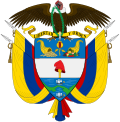| Party | Votes | % | Seats | +/– |
|---|
| Colombian Liberal Party | 2,710,599 | 29.19 | 29 | –19 |
| Colombian Conservative Party | 885,263 | 9.53 | 13 | –2 |
| Coalition | 565,222 | 6.09 | 6 | –1 |
| National Movement | 411,029 | 4.43 | 6 | – |
| Team Colombia | 297,538 | 3.20 | 4 | – |
| Colombia Always | 255,691 | 2.75 | 2 | – |
| People's Integration Movement | 254,616 | 2.74 | 4 | – |
| Radical Change | 222,484 | 2.40 | 2 | – |
| United People's Movement | 172,717 | 1.86 | 2 | – |
| Renovation Movement Labour Action | 152,481 | 1.64 | 1 | – |
| Social and Political Front | 128,079 | 1.38 | 1 | – |
| New Democratic Force | 124,130 | 1.34 | 1 | 0 |
| National Popular Alliance | 119,022 | 1.28 | 1 | 0 |
| Independent Social Alliance Movement | 103,370 | 1.11 | 1 | 0 |
| Colombian Social Democratic Party | 101,660 | 1.09 | 1 | – |
| Progressive Force | 96,787 | 1.04 | 1 | +1 |
| New Liberalism | 93,987 | 1.01 | 1 | – |
| Citizens' Convergence | 91,131 | 0.98 | 1 | +1 |
| Civic People's Convergence | 85,764 | 0.92 | 1 | 0 |
| Unionist Movement | 85,713 | 0.92 | 1 | – |
| Independent Movement of Absolute Renovation | 81,061 | 0.87 | 1 | – |
| Progressive National Movement | 80,300 | 0.86 | 1 | –1 |
| National Salvation Movement | 78,080 | 0.84 | 1 | 0 |
| Alternative for Social Advance | 77,916 | 0.84 | 1 | – |
| Let the Moreno Play Movement | 71,623 | 0.77 | 1 | – |
| Political Movement for Social Security | 70,704 | 0.76 | 1 | – |
| We are Colombia | 70,699 | 0.76 | 1 | – |
| Vamos Colombia | 66,512 | 0.72 | 1 | 0 |
| C4 | 65,294 | 0.70 | 1 | 0 |
| People's Will Movement | 63,533 | 0.68 | 1 | – |
| Citizens' Footprint Movement | 63,165 | 0.68 | 1 | – |
| Colombian Community and Communal Political Movement | 56,363 | 0.61 | 0 | 0 |
| Yes Colombia | 55,835 | 0.60 | 1 | – |
| Citizens' Movement | 51,504 | 0.55 | 1 | 0 |
| Democratic Unity Party | 48,939 | 0.53 | 1 | – |
| Front of Hope | 46,298 | 0.50 | 1 | 0 |
| Revolutionary Independent Labour Movement | 45,703 | 0.49 | 1 | +1 |
| Independent Civic Movement | 43,265 | 0.47 | 1 | +1 |
| Citizens' Political Movement for Bocaya | 42,954 | 0.46 | 1 | – |
| Democratic Progressivity | 41,672 | 0.45 | 1 | – |
| Christian National Party | 40,460 | 0.44 | 1 | – |
| Laicists for Colombia | 37,125 | 0.40 | 0 | –1 |
| Christian Union Movement | 36,675 | 0.39 | 0 | 0 |
| Indigenous Authorities of Colombia | 35,215 | 0.38 | 1 | +1 |
| Democratic Renovation Movement | 34,049 | 0.37 | 0 | 0 |
| National Union for Social Security | 29,430 | 0.32 | 0 | – |
| Community Participation | 28,319 | 0.30 | 0 | – |
| Colombia My Country | 23,770 | 0.26 | 0 | –1 |
| Democratic Alternative Movement | 23,271 | 0.25 | 0 | 0 |
| National Civic Concentration | 21,191 | 0.23 | 0 | 0 |
| Independent Conservatism | 20,503 | 0.22 | 0 | –1 |
| Humbertista Movement | 19,868 | 0.21 | 0 | 0 |
| ANUPAC | 13,387 | 0.14 | 0 | – |
| National Democratic Reconstruction | 12,693 | 0.14 | 0 | –1 |
| Civic Defence Movement | 12,015 | 0.13 | 0 | –2 |
| Social Democratic Party | 11,279 | 0.12 | 0 | 0 |
| Colombian Indigenous Party | 11,266 | 0.12 | 0 | New |
| Autonomous Citizens' Movement | 6,845 | 0.07 | 0 | – |
| People's Participation Movement | 6,762 | 0.07 | 0 | 0 |
| Force Colombia | 4,707 | 0.05 | 0 | 0 |
| Democratic Revolution Movement | 3,899 | 0.04 | 0 | – |
| Independent Liberal Restoration Movement | 1,442 | 0.02 | 0 | 0 |
| Colombian People's Party | 1,400 | 0.02 | 0 | –1 |
| Others | 217,161 | 2.34 | 2 | – |
| Blank votes | 454,740 | 4.90 | – | – |
| Total | 9,286,175 | 100.00 | 102 | 0 |
|
| Valid votes | 9,286,175 | 90.18 | |
|---|
| Invalid votes | 1,011,228 | 9.82 | |
|---|
| Total votes | 10,297,403 | 100.00 | |
|---|
| Registered voters/turnout | 23,998,685 | 42.91 | |
|---|
| Source: Nohlen |
